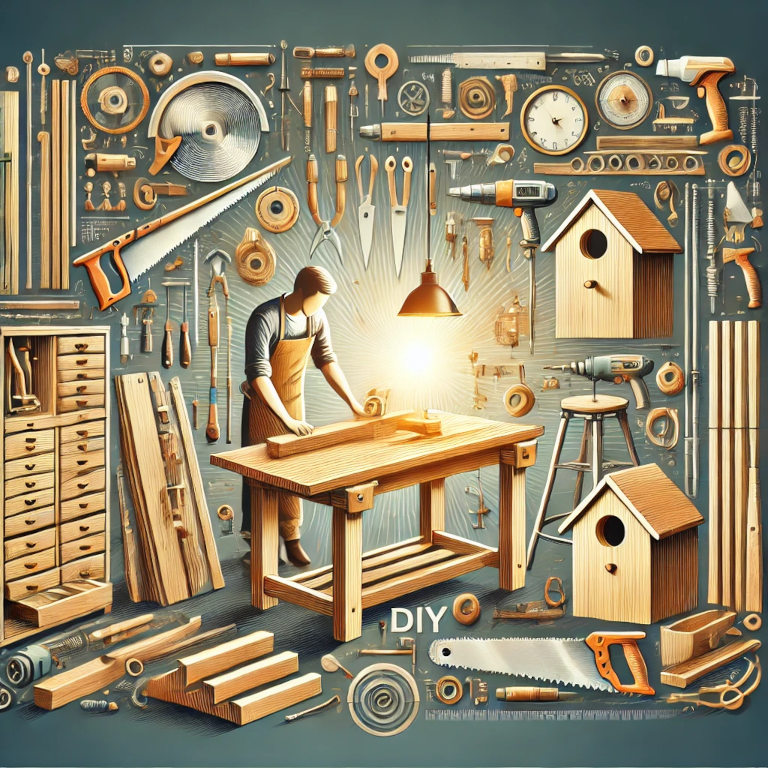DIY woodworking is a rewarding and creative hobby that allows you to create functional and beautiful pieces from wood. Whether you’re a seasoned woodworker or a beginner, there are endless possibilities to explore. As an expert in DIY and Crafts, I will guide you through the essentials of DIY woodworking, offering tips, techniques, and project ideas to help you get started or enhance your skills.
Understanding DIY Woodworking
DIY woodworking involves crafting items from wood using various tools and techniques. It ranges from simple projects like building a shelf to more complex endeavors like crafting furniture. This hobby not only allows you to create custom pieces but also provides a sense of accomplishment and the opportunity to develop new skills.
Essential Tools for DIY Woodworking
- Measuring Tools: Accurate measurements are crucial in woodworking. Essential tools include a tape measure, combination square, and a ruler. These tools ensure precise cuts and fits.
- Cutting Tools: A variety of cutting tools are necessary for different projects. A handsaw, circular saw, and jigsaw are versatile options for making straight and curved cuts. A miter saw is excellent for precise angle cuts.
- Drilling and Fastening Tools: A power drill and a set of drill bits are indispensable for creating holes and driving screws. A hammer and a selection of nails and screws are also essential for assembling your projects.
- Sanding Tools: Sanding smooths out rough edges and prepares the wood for finishing. A random orbital sander is a versatile tool for most sanding tasks, while sanding blocks are useful for detailed work.
- Clamps: Clamps hold pieces of wood together while the glue dries or during assembly. Bar clamps, pipe clamps, and C-clamps are commonly used in woodworking.
- Workbench: A sturdy workbench provides a stable surface for your projects. It should be durable and equipped with a vice to hold materials securely.
- Safety Gear: Safety is paramount in woodworking. Always wear safety glasses, ear protection, and a dust mask to protect yourself from sawdust and noise.
Basic Techniques in DIY Woodworking
- Measuring and Marking: Begin each project by measuring and marking your wood accurately. Use a pencil and a combination square to draw straight lines and precise angles.
- Cutting: Practice making straight cuts, angled cuts, and curved cuts with your saws. Ensure your cutting tools are sharp for clean, accurate cuts.
- Drilling: Learn to drill straight and angled holes. Start with a small pilot hole to guide your drill bit and prevent the wood from splitting.
- Sanding: Sand your pieces progressively with finer grits of sandpaper to achieve a smooth finish. Always sand with the grain of the wood to avoid scratches.
- Assembling: Use wood glue and clamps to join pieces of wood securely. Reinforce joints with nails or screws for added strength.
- Finishing: Apply a finish to protect your wood and enhance its appearance. Options include paint, varnish, stain, and oil. Sand lightly between coats for a smooth, professional finish.
Project Ideas for DIY Woodworking
- Simple Shelf: A basic shelf is an excellent beginner project. It involves measuring, cutting, sanding, and assembling a few pieces of wood. You can customize the dimensions and finish to fit your space.
- Cutting Board: A cutting board is a functional and straightforward project. Use hardwood like maple or walnut, and practice precise cutting and sanding for a smooth surface.
- Picture Frame: Crafting a picture frame involves mitered cuts and careful assembly. This project helps develop your precision and attention to detail.
- Birdhouse: A birdhouse is a fun project that allows for creativity in design. It involves measuring, cutting, drilling, and assembling, providing a comprehensive woodworking experience.
- Bookshelf: A bookshelf is a practical and rewarding project. It requires accurate measurements, cutting, drilling, and assembling, and allows you to create custom storage for your books.
- Coffee Table: A coffee table is a more advanced project that involves designing, cutting, sanding, and finishing. It provides an opportunity to practice joinery and create a centerpiece for your living room.
Tips for Success in DIY Woodworking
- Start Simple: Begin with easy projects to build your skills and confidence. Gradually take on more complex projects as you become more comfortable with the tools and techniques.
- Plan Ahead: Draw a detailed plan of your project, including measurements and materials needed. Planning helps prevent mistakes and ensures a smooth workflow.
- Practice Patience: Woodworking requires precision and patience. Take your time with each step, and don’t rush the process. Attention to detail leads to better results.
- Learn from Mistakes: Mistakes are part of the learning process. Analyze what went wrong and how to avoid it in the future. Each mistake is an opportunity to improve.
- Seek Inspiration: Look for inspiration in books, magazines, online tutorials, and woodworking communities. Seeing different techniques and projects can spark new ideas and approaches.
Summary
DIY woodworking is a fulfilling and creative hobby that allows you to craft beautiful and functional items from wood. By understanding the essential tools, mastering basic techniques, and starting with simple projects, you can develop your skills and create custom pieces for your home. With patience, practice, and a passion for craftsmanship, you can enjoy the art of woodworking and the satisfaction of creating something unique and enduring.






